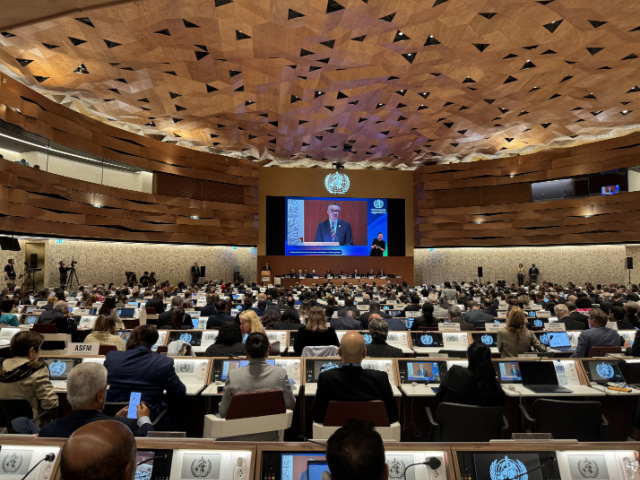The World Health Organization (W.H.O.) published a study this weekend documenting a dramatic decline in global life expectancy to 2012 levels immediately following the onset of the coronavirus pandemic.
The annual World Health Statistics report, published on Friday, was released in anticipation of the U.N. body’s yearly gathering, the World Health Assembly (WHA), which began on Monday in Geneva. The W.H.O. convenes its member states for the W.H.O. to address concerning health trends around the globe, modify or improve international law pertaining to public health, and discuss ways of preventing future emergencies. Much of the energy regarding this 2024 event has been around negotiations for a treaty or other international legal documents governing the global response to pandemics, a controversial idea that W.H.O. Director-General Tedros Adhanom Ghebreyesus has been aggressively campaigning for since 2021.

A general view of the opening session of the 77th World Health Assembly in Geneva, Switzerland on May 27, 2024 (Photo by Muhammet Ikbal Arslan/Anadolu via Getty Images).
The working group that has for years been working on a draft pandemic accord failed to agree on a full draft to present to the World Health Assembly this year, though it will present the sum of its findings on Tuesday.
In addition to directly addressing future pandemics, WHA participants will also address alarming trends in public health following the onset of the pandemic, among them the decline in life expectancy.
“In just two years, the COVID-19 pandemic reversed over a decade of gains in both life expectancy at birth and healthy life expectancy (HALE),” this year’s World Health Statistics report read. “By 2020, both global life expectancy and HALE had rolled back to 2016 levels (72.5 years and 62.8 years, respectively). The following year saw further declines, with both retreating to 2012 levels (71.4 years and 61.9 years, respectively).”
The study found that the Americas and South-East Asia saw the largest declines in life expectancy. In the Americas, life expectancy dropped by “about 3 years.”
The decline followed what the report called “steady gain” in improving life expectancy between 2000 and 2019. Life expectancy around the globe increased from an average of 66.8 years in 2000 to 73.1 years in 2019.
“Due largely to the impact of the COVID-19 pandemic, global life expectancy and healthy life expectancy have both regressed to the level a decade ago, although the impact was unequal across regions and income groups,” Tedros wrote in his foreword to the report. “This regression and its associated inequality signal significant challenges to health systems, demanding urgent attention and action.”
The W.H.O., in its summary of the report, lamented, “The pandemic wiped out nearly a decade of progress in improving life expectancy within just two years,” directly attributing the change to the abrupt onset of the pandemic.
The annual report did not mention government actions taken during the pandemic as a potential factor in declining health independent from SARS-CoV-2 infections on their own. The report did not mention “lockdowns” by name, the forced internment of people in quarantine camps in places such as China and Australia, or concerns such as patients not going into clinics for preventative care during the peak of the pandemic to avoid coronavirus infections. Preventative care is critical for saving lives from many noncommunicable diseases (NCDs), such as diabetes, cancer, and heart disease.

A woman with children wearing face masks wait at a temporary makeshift treatment area outside Caritas Medical Centre in Hong Kong, Friday, Feb. 18, 2022. Hong Kong’s hospitals reached 90% capacity on Thursday and quarantine facilities were at their limit, authorities said, as the city struggles to snuff out a record number of new COVID-19 cases by adhering to China’s “zero tolerance” strategy (Kin Cheung/AP).
The study noted that NCDs remained a significant challenge during the pandemic and “were the biggest killers before.”
“Even during the pandemic, NCDs continued to account for 78% of non-COVID deaths,” the report observed.
The W.H.O. also published new statistics on suicide, finding that the Americas was the only region documenting an increase in suicides from 2000 to 2021.
Tedros used the results of the study to promote the yet-to-be-completed pandemic accord.
“In just two years, the COVID-19 pandemic erased a decade of gains in life expectancy. That’s why the new Pandemic Agreement is so important,” Tedros said in a statement following the publication of the report. “Not only to strengthen global health security, but to protect long-term investments in health and promote equity within and between countries.”
Past W.H.O. reports have suggested that pandemic-related lockdowns had an adverse effect on some health indications. A 2022 report found a 25-percent global increase in anxiety and depression in 202o, for example.
“Restrictions imposed during the COVID-19 pandemic for example had significant mental health consequences for many, including stress, anxiety or depression stemming from social isolation, disconnectedness and uncertainty about the future,” the W.H.O. asserted at the time.
The agency also noted that child abuse was a significant part of the decline in mental health: “For some children and adolescents, being made to stay at home is likely to have increased the risk of family stress or abuse, which are known risk factors for mental health problems.”
The W.H.O. also published a report in 2022 finding that insufficient exercise was responsible for as much as $27 billion in unnecessary healthcare spending for those suffering from obesity and other related issues.
“The [coronavirus] pandemic has shown that physical activity must be a core component of public policy, with all countries ensuring provision of equitable physical activity opportunities for all,” the agency declared in that report, in defiance of the mass shutdown of parks, gyms, beaches, playgrounds, and other places commonly used for physical activity.


COMMENTS
Please let us know if you're having issues with commenting.